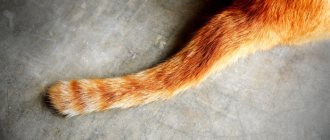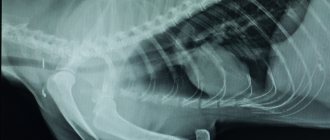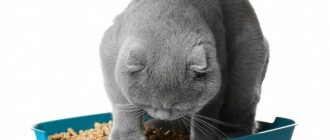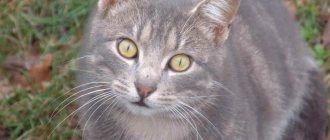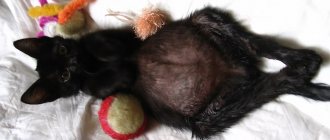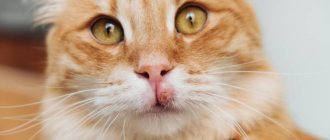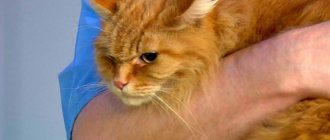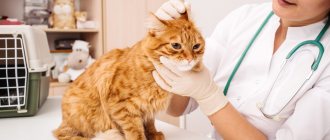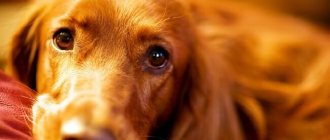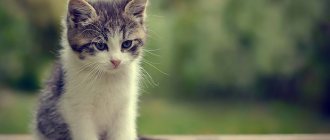4241Pavel
Volvulus is a rather dangerous phenomenon for both humans and animals. You should take immediate action if you see all the symptoms of volvulus. In cats and dogs, this problem should be correctly diagnosed, because, unlike humans, our pets cannot tell what hurts them and where. When intestinal volvulus occurs, you should react quickly and correctly recognize all clinical signs. The life of the animal largely depends on the speed of diagnosis and action. This problem leads to tissue death, a sharp deterioration in the cat’s condition, and disruption of the blood supply to the gastrointestinal tract.
How dangerous is the disease?
Intestinal volvulus is a pathological process in which the mesenteries or gastric ligaments are twisted, which leads to pinching of the main artery that supplies the intestines with blood. Thus, the anatomical location of the intestine and its blood supply are disrupted. The supply of nutrients to the organs and the process of fluid absorption stops, so the sick pet is in serious danger if therapy is not started.
When the cranial artery is completely clamped, tissue death (necrosis) rapidly occurs, which completely affects the intestinal section and peritonitis occurs in the sick pet.
There may be cases when one part of the intestine is screwed into the lumen of another - this also leads to obstruction, but is called intussusception.
Both with volvulus and intussusception, professional help is needed; you cannot cope with this on your own.
Causes of appearance: what is the provocateur?
According to veterinary statistics, kittens up to one year old are susceptible to the disease, but it also occurs in adults.
Volvulus usually occurs in animals with increased intra-abdominal pressure. This disorder occurs in cats that are exposed to excessive physical activity (running, jumping) immediately after eating. There should be a break between eating and activity. Another common cause is poor diet, which causes intestinal obstruction. If a long period of hunger is replaced by overeating, then gastric volvulus develops. The disease occurs when foreign bodies get inside the cat, often small bones from fish or meat.
Pathology can develop against the background of a hernia in a pet.
Other causes of volvulus:
- constipation;
- intestinal paresis;
- oncological diseases of the gastrointestinal tract;
- hernias
Causes of the disease
Experts do not name the exact causes of the disease, there are only assumptions:
- A short break between feeding and energetic games.
- Pathological processes of the gastrointestinal tract (parvovirus infection, severe helminthic infestations, etc.).
- Mechanical damage.
- Hormonal imbalance, which causes subsequent weakening of the ligaments or their excessive elasticity.
- Foreign body - the curiosity of kittens leads to the testing of various inedible objects, which often causes blockage, and this in turn can cause intussusception.
- Tumors of various types - when foreign formations obstruct the passage of gastric waste, which causes a blockage, which may result in volvulus.
According to statistics, the most susceptible to intussusception are those under one year of age (it forms in the part of the intestine where the ileum becomes the cecum). In more mature individuals, invaginations (volvulus) occur due to the consumption of any unusual objects or due to malignant formations.
What is
The esophagus and stomach are attached to each other using special ligaments - mesenteries. Thanks to them, the intestines are correctly located in the abdominal cavity, able to function normally and maintain natural blood supply. If the mesentery twists, a volvulus occurs, blocking the main artery that carries blood to the intestines.
Intestinal obstruction is often confused with volvulus, but these are completely different conditions. Obstruction occurs due to the closure of the intestinal gap, which, with varying degrees of probability, can impair the blood supply. When a volvulus occurs, the intestine is guaranteed to be deprived of blood access, which in a short time causes tissue necrosis.
If the main artery is completely compressed, then the death of the smooth epithelium occurs in a matter of minutes. Ischemia causes rapid inflammation of the abdominal cavity and peritonitis.
Symptoms
The fundamental sign of intussusception is vomiting. At the same time, the animal makes it clear with its plaintive meows that it is in extreme pain. Other manifestations that will let the pet owner know that the animal should be taken to the veterinary clinic immediately are:
- Sudden changes in behavior - the patient's apathy and dejection, or vice versa, the mustache's constant running from place to place as a way to attract attention to itself.
- Refusal of treats, because the mustache understands that with food it will become even worse.
- The urge to vomit or the immediate appearance of vomit (often interspersed with blood).
- A sick mustache does not allow him to touch his tummy (it becomes hard and inflated) - this gives him acute pain.
- Gases accumulate in the cat's body, so the mustache may begin to roll on the floor, trying to free itself from them.
- The patient does not defecate - the absence of feces in the tray for a long time can be both a sign of constipation and obstruction. But if in the first case, the cat can still sometimes go to the toilet, then with volvulus in cats, in addition to the listed symptoms, there is a complete absence of bowel movements (surgical intervention is necessary).
- Shock state - nutrients and oxygen do not reach the intestines, this situation leads to hypovolemic shock.
- The patient's body becomes dehydrated and therefore the mustache literally dries out before our eyes (its body weight decreases).
Vaseline oil
Dry feces in small quantities indicate impaired peristalsis. The longer waste products are not removed from the body, the stronger the intoxication. In the absence of bowel movements, it is recommended to use Vaseline oil. This is an emergency measure that should not be abused. Experts usually prescribe 5-10 ml per dose.
There are many manufacturers
The result should appear in 4-5 hours. If bowel movement does not occur, you can give 5 ml again. The maximum dose for an adult is 20 ml per day. To give Vaseline oil to a cat, use a regular syringe without a needle. Administer orally strictly at the root of the tongue. Otherwise, the purr may spit it out. The drug is addictive, so use only as a last resort and after consultation with a specialist.
Sometimes owners do not go to the clinic and try to alleviate the suffering on their own. You should consult your veterinarian about how to cleanse your cat’s intestines. It will also eliminate serious problems for which laxatives should not be given.
Intestinal obstruction in cats
There is a complete or partial cessation of fecal movement. Caused by two factors:
- ingestion of a foreign body that is not digested,
- tumors, volvulus or penetration of one intestine into another, hernia.
Such conditions are dangerous. Vomiting is typical, with it a large amount of moisture and nutrients are lost. Attempts to get him drunk do not bring results. They only provoke the process even more. If assistance is not provided, death can occur within 2-5 days. The closer to the stomach the blockage occurs, the more severe the illness. There is no need to give antiemetic drugs. They only mask the disease and have no therapeutic effect.
Laxative measures do not help if constipation is caused by volvulus or obstruction. Contractions will push the foreign object forward, damaging the mucosa.
Professional help
With intussusception, X-ray images show a clear picture of stretching of the small intestine. There may be liquid in the cavities. A specialist will not be able to tell the owners for sure that the pet has bloat; only surgery will give an accurate answer. Unfortunately, many mustachioed creatures die before they can reach the clinic with their owners.
If the pet was successfully delivered, then the animal will undergo surgery at the veterinary clinic - this is the only way to rid it of the problem.
During the operation, the specialist must carefully examine all parts of the intestine and give the twisted area a normal anatomical position. Tissues that have undergone necrosis will be removed.
If the lesion has affected most of the tissues, then complete removal of the small intestine is possible; in this case, the mustachioed creature will need maximum care, since it will need to be constantly taken to courses of maintenance therapy and its nutrition will be strictly monitored for the rest of its life.
Volvulus
Intussusception occurs more often in infants (between 4 and 10 months of age) who are well nourished. The disease begins suddenly. The child becomes restless, cries, squirms, and tightens his legs. The attack ends as unexpectedly as it began. The child calms down and even plays, but after a while the attacks of pain recur again. Attacks of pain correspond to waves of intestinal peristalsis, which move the invaginated part of the intestine forward. Attacks of pain occur in 90% of cases of the disease. Soon after the first attacks of pain, vomiting occurs once or twice, which also occurs periodically. At the beginning of the disease, vomiting is of a reflex nature, and then the cause becomes obstruction of the lumen of the invaginated intestine. Body temperature usually remains normal. Initially, the child has normal stools 1-2 times, but later, after 6-10 hours, blood appears in the stools and they take on the characteristic appearance of “raspberry jelly.” Later, the release of feces and gases stops. Due to compression of the invaded section of the intestine and the corresponding section of the mesentery, severe circulatory disorders occur in them. Inflammatory phenomena lead to sticking of the cylinders, which prevents the straightening of the intussusception. With careful palpation in the intervals between attacks, the abdomen is soft and not swollen. During an attack, the child reflexively tenses the abdominal muscles and the abdomen cannot be thoroughly examined. It is often possible to palpate an invaginated area of the intestine, a tumor-like formation of soft-elastic consistency, sausage-shaped, painful on palpation. The tumor changes its shape and location depending on the duration of the disease and intestinal motility. The literature describes cases when intussusception, having passed through the colon, falls out of the anus, and is mistaken for a prolapsed rectum. The severity of the condition of a child with intussusception can be judged by the pronounced symptoms of intoxication. In cases of late diagnosis, clinical peritonitis develops, the abdomen becomes swollen, tense, and sharply painful on palpation in all parts. The examination of the child ends with examination through the rectum. In some cases, it is possible to palpate the tumor bimanually. After removing the finger from the anus, mucus with blood is released, without admixture of feces.
Recovery after illness
After surgery, the pet will be prescribed antibiotic therapy, as well as painkillers. All this has a detrimental effect on the animal’s microflora, so probiotics and a strict diet will most likely be prescribed to restore it.
In most cases, the pet will not be able to eat food on its own after such a serious operation.
Therefore, the specialist will install a catheter to allow liquid food to flow directly through the stomach. To do this, a latex tube is inserted through the nose and throat, or there is a second method (when food is supplied directly) - cutting a hole in the abdominal cavity.
After the mustache has gone home after surgery, it is extremely important for the owners to maintain sterility in everything while the animal recovers its strength. If at this moment any infection attaches to the animal, then most likely the pet will not be able to survive.
Treatment
Intestinal obstruction is a rapidly developing disease in which the cat requires the most prompt assistance. In most cases, surgery is the only chance to save the life and health of a pet . After an x-ray, which shows the location of the volvulus, the doctor begins preparations for surgery. The specialist decides whether the intestine can be cut out or another method is used.
- If a large area is affected by necrosis, the veterinarian will completely remove the intestine. It returns the twisted section to the correct anatomical position.
- The doctor may have to suture the small intestine, and this will lead to problems caring for the pet. Beneficial elements and vitamins are absorbed in the small intestine. The owner should know that after such surgical treatment the animal will need a diet and competent supportive therapy.
- After surgery, therapy includes taking antibiotics and medications that support the microflora. Probiotics are taken as prescribed by the doctor.
Actions of the owner in case of suspected bloat
If it is noticed that your pet has eaten some inedible object, or symptoms reminiscent of signs of bloat are observed, then you should immediately take the mustachioed creature to the veterinary clinic for an x-ray and examination.
What not to do:
- Offer your pet treats, let alone force feed her.
- Give the purr antiemetic drugs.
- Offering your cat drugs with a laxative effect can aggravate the problem and cause complete rupture of the intestine.
Diagnostic methods
If a dog has a volvulus, the symptoms of this disease cannot be ignored and pet owners must be aware of them in order to provide timely assistance. This rather serious situation can lead to serious consequences for a four-legged pet; there are even cases of death of the animal.
The dog's stomach is an elastic sac connected to the esophagus and intestines on two opposite sides. Food masses, entering it through the esophagus, push air back out. With the help of gastric juice, which dissolves food, the digestion process begins. The stomach, when full, stretches and reaches the lower wall of the abdomen. This ability is responsible for its possible twisting around the esophagus or spleen.
Most often, large breed dogs suffer from this disease: bullmastiffs, Dobermans, shepherds, Great Danes, Labradors. It is treated exclusively surgically after identifying the disease in order to differentiate between dilation and volvulus of the stomach, which have the same clinical picture.
An animal suffering from a volvulus will exhibit the following signs of the disease:
- severe anxiety;
- painful sensations in which the pet cannot find a place for itself and looks for the most comfortable position;
- nausea and vomiting;
- increase in abdominal size;
- lack of stool.
After a few hours, the temperature drops, the mucous membranes turn pale, breathing becomes difficult, shortness of breath and profuse salivation appear. There is weakness and trembling of the limbs, anxiety gives way to lethargy.
A dog with symptoms of volvulus requires immediate hospitalization and evaluation. A gastric tube is used to check for volvulus (the tube does not pass into the stomach) or gastric dilatation (bloating due to gases that are pushed out by the tube). If time permits, an x-ray is taken to determine the affected area.
Most often, the animal undergoes surgery to completely eliminate the necrotic areas of the intestine and properly rotate the stomach. A probe is placed to remove food masses, the stomach is washed and sutured to the walls of the abdomen so that there are no relapses. Tissues affected by necrosis are removed.
The dog remains in the hospital for several days. She is given antibiotics and antiemetics, her sutures are treated, and parenteral feeding is used if necessary.
To prevent such a dangerous illness as volvulus, you should follow certain rules:
- The dog should be fed at least 3 times a day in small portions.
- Use high quality feed (not lower than premium) with easily digestible ingredients.
- After feeding, you should not immediately walk your pet. Physical activity and training immediately after eating are unacceptable.
- If possible, try to avoid stressful situations for your pet (long trips, change of owners).
- Closely monitor the condition of the gastrointestinal tract. In the presence of chronic diseases, carefully and timely carry out the necessary course of treatment, avoiding exacerbations.
If you have the slightest suspicion of gastric torsion, you should immediately contact a veterinary clinic for the necessary assistance.
At the appointment, the doctor performs an initial examination of the cat and palpates its abdomen. When tapping, a specific sound is determined, reminiscent of a drum. In the initial stage of intestinal obstruction, peristalsis can be heard well; with late treatment, it becomes weaker. On palpation, the doctor feels swelling in part of the abdomen. To further clarify the diagnosis, the following methods are used:
- Radiography. The study does not require preparation and is carried out on an emergency basis. An x-ray allows you to clearly study areas of the intestine that are dilated from the presence of gases, liquids and feces. Such expansion is a characteristic sign of obstruction.
- Colonoscopy. With partial obstruction, the disease can have a chronic course. In this case, it is recommended to do a colonoscopy, in which the veterinarian examines the walls of the large intestine by inserting a probe into the anus, which transmits an image to a monitor.
- Ultrasound. The ultrasound method is used to detect tumors in the intestine. It does not allow you to accurately determine the presence of obstruction, therefore it is auxiliary.
- Irrigoscopy. This method allows you to take an image using a contrast agent. Information obtained in this way makes it possible to more accurately judge the presence of obstruction and other intestinal pathologies.
Diagnostics
The chance of recovery increases when the pet is taken to the clinic immediately after refusing food. If it turns out that the cat has stool retention, the veterinarian will have more time to clarify the cause of the pathology.
It is necessary to exclude constipation, in which the main symptoms are similar, but the treatment is different. Thus, Vaseline oil, which helps with stool retention, is contraindicated when the cat has intestinal obstruction. If the fellinologist notices some of the above manifestations, it is necessary to urgently hospitalize the cat, sometimes the hours are counting. An X-ray of the abdominal cavity with contrast filler is informative.
Blood tests are necessary to assess the severity of organ damage and the degree of intoxication. In some situations, it will take months to determine the definitive cause of the obstruction.
Therapy consists of surgery. The veterinarian makes an attempt to flush the intestines. If it is determined that it is clogged with insoluble substances, for example, polyethylene, or the patient’s condition is serious, abdominal surgery is performed. It involves removing a foreign object. The condition of the intestinal wall is assessed and if a focus of necrosis is detected, the affected areas are excised.
If incomplete intestinal obstruction is diagnosed, the disease is treated on an outpatient basis. Most treatment procedures are carried out by a fellinologist in an apartment, under medical supervision. The veterinarian warns the cat owner not to use laxatives until an accurate diagnosis has been made. If there is a blockage with a foreign object, spasms may occur, leading to rupture of the intestine.
Treatment at home
If urgent surgery is not required, the fellinologist is required to be diligent and attentive. Before making a final diagnosis, symptomatic treatment is carried out, consisting of the following:
- The cat is provided with peace and comfort.
- A diet of liquid or wet ingredients is prescribed.
- Dehydration is combated by drip administration of rehydration solutions.
- Stimulate peristalsis by placing an enema.
- Populate the large intestine with beneficial microflora using probiotics.
- To speed up the passage of digested masses through the intestines, Vaseline oil or other laxatives are used.
- Immunostimulants are indicated as general strengthening agents.
- To stop the decomposition processes of necrotic areas, antibiotics are prescribed.
- If, after eliminating the obstruction, diarrhea develops, get rid of its consequences.
How to get rid of hair
Cats that have a caring owner have nothing to fear. You should understand that you need to provide assistance to your pet and carry out hair removal procedures regularly. To do this, you can resort to some fairly popular methods.
Natural food
When living in a private house, the cat can freely walk around the yard. As noted, many pets are able to feel that ordinary green grass will help them get rid of hair. After the animal eats it, vomiting will begin. And it is at this time that the hairs, along with mucus and grass, will come out of the cat’s body.
Purchasing special feed
Many companies specializing in the production of food for four-legged residents produce special lines. They help to establish the procedure for removing hair from the stomach. This is due to the fact that the feed is impregnated with special plant fibers and oils. These substances help remove hairs in feces.
Such food should most often be given to pets during the molting period. You can choose products based on your cat’s taste preferences. It is worth understanding that it will be difficult to make a choice the first time, since not all products may appeal to your four-legged friend.
Phytomines
The procedure for removing hair from the stomach may be based on taking a special mineral complex. It includes plant extracts. They help cleanse the stomach of unnecessary hairs.
Among the extracted plants, the roots of licorice, plantain, and yarrow should be highlighted. The complex can also be made on the basis of violet and centaury. You cannot feed phytomines to an animal that is not yet 8 months old. For older pets, tablets should be given 2 times a week, 2 pieces.
Using the paste
Cliny paste can be used to remove hair. It contains vegetable oils. In addition, the paste includes a huge number of ballast elements. They have a pleasant smell and help improve digestion. Before feeding, the paste should be mixed with the regular food that you give your pet regularly.
It is best to give this hair remover during the shedding period. Basically, all cats without exception like Cliny paste. “Malt-paste” has also proven itself well.
Purchasing Special Herbs
Not only Cliny paste can be used to remove hair from the stomach. At the present stage, cleansing herbs are sold in specialized pharmacies. They just need to be sown in a pot and placed on the windowsill. You can choose a place where your cat likes to spend his time.
As soon as the sprouts hatch, the pet will begin to eat them. If he doesn’t pay attention to the plant, you can plant it next to the pot and show him the sprouts. After this, basically all pets begin to feast on cleaning products.
This herb is a natural product with which the procedure for removing hair from the stomach does not require your personal intervention. Sprouted sprouts can be fed to your pet, regardless of the time of year outside.
It should also be noted that the cleansing herb, like the paste, is rich in amino acids, minerals and B vitamins.
The video will show how cats eat grass.
Buying treats
Cleansing sweets are simple sticks. There is paste inside them. The taste of sweets may vary. Therefore, when purchasing, you should be guided by your pet’s taste preferences. Treats cannot replace vitamins and minerals. They act as a quality supplement to the main diet. They can be fed to picky eating animals.
Vaseline oils
At home, the procedure for removing hair from a pet’s body can be based on the use of petroleum jelly. This remedy is mainly used when the cat cannot go to the toilet “in a big way.” But you should not use a product to remove hair from the stomach. It is better to additionally consult a veterinarian.
You can purchase the substance at a veterinary pharmacy. It has a laxative effect, coats the intestinal walls and helps get rid of hairballs. The oil has the appearance of a clear, odorless liquid.
The product must be poured into the pet's mouth. This may require a syringe without a needle. A single dose includes 3-4 ml. In general, cats are not likely to like this withdrawal procedure. For this reason, an assistant may be required to hold the animal firmly.
Treatment of intestinal obstruction in cats
As a result of establishing the cause, further actions can be judged: either conservative therapeutic treatment of the sick animal is carried out, or emergency surgery is performed to eliminate the cause of blockage of the intestinal lumen (if a foreign body, hernia, tumor, etc. is detected).
Surgery is also necessary if symptoms persist or worsen, or if signs of peritonitis are noted.
In all cases, special attention should be paid to stabilizing the animal and restoring fluid and electrolyte balance after surgery

